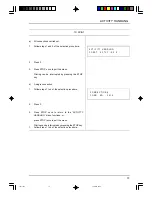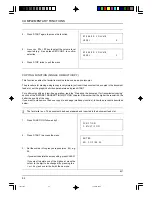
ACTIVITY HANDLING
71
ACTIVITY HANDLING
The facsimile machine has a working memory structured so that you can keep track of all the activities carried
out (the only operations that are not recorded in the memory are: immediate transmission from the ADF and
reception not into the memory).
The availability of a structured memory provides many advantages both from a functional point of view (a
single setting for different times and correspondents) and an economical point of view (use of the facsimile
machine at low-cost times). Reliable reception (even when there is no paper or ink left) is provided by
optimized use of the memory. The memory cannot be used when there is less than 25% left so there is
sufficient space to ensure reception. When the space available in the memory falls to 25%, the facsimile
machine prevents other documents from being stored and displays the message "TX MEMORY FULL".
ACCESS TO “ACTIVITY HANDLING”
The AVAILABLE FUNCTIONS column lists the functions in abbreviated form exactly as they appear on the
display while the full name of each function is given in the “Function keys” section of the “GETTING TO KNOW
THE FACSIMILE MACHINE” chapter.
The functions can be selected independently without having to follow the order in which they are presented
in the manual. For a more detailed description of each function, see the following sections.
Within each function (except for the data concerning documents waiting to be printed) you can select, print
or delete the data stored. The keys used are the following:
For a detailed description of the keys, see the “Console” section of the “GETTING TO KNOW THE FACSIMILE
MACHINE” chapter.
Note:
All the procedures described in this chapter can be interrupted at any time by pressing STOP once
or twice, depending on the procedure.
If no data is entered for two minutes during a procedure, the procedure is automatically aborted
and the facsimile machine returns to stand-by.
START
∨
∧
D
3
SPEED DIAL
REDIAL
0
KEYS
MENU
AVAILABLE FUNCTIONS
ACTIVITY HANDG
CONCT. ACTVY
DOCS. STORED
FUNCTION
CLEAR
TALK
cap11.p65
13/04/00, 22.36
71
















































